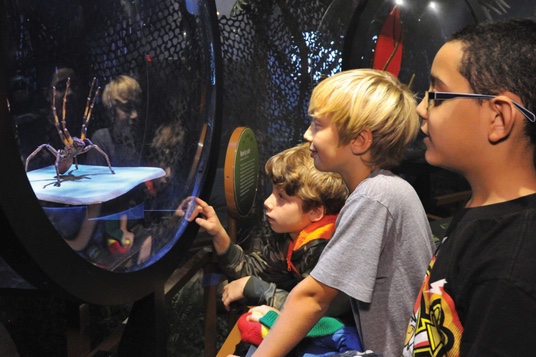
Sat 2/27—Sun 7/24
Bell Biv Devoe famously sang “That girl is poison.” But odds are the only thing the R&B act had in common with an actual toxin was its colorful, early ’90s outfits that resembled tints and shades common with the golden poison frog and poison dart frog.
Those amphibians and more are a part of the Cleveland Museum of Natural History’s new exhibit The Power of Poison which runs Sat 2/7 through Sun 7/24 in Kahn Hall. The unique interactive display examines the evolutionary interactions between predators and prey involving plants, animals, fungi and bacteria.
CoolCleveland talked to the Cleveland Museum of Natural History Postdoctoral Fellow of Human Health and Evolutionary Medicine Dr. Nicole Burt about the ins and outs of deadly poisons.
What has you excited about the The Power of Poison exhibit?
Poison is a really fun topic. It’s both frightening and interesting. People will have a lot of really visceral reactions to it when you say poison. This particular exhibit is really cool because it’s really immersive. You start off in the “Poison in Nature” section, where you get to see a live animal. We have poisonous frogs, which are not poisonous, in the gallery. They have to eat the beetles to be poisonous. Then there’s a “Myth and Legends” section, which has really amazing displays. My personal favorite is the “Mad Hatter” section. That’s really cool to me because it is a literary tale but based in history. Mad Hatter Syndrome is actually a real disease hatters got from mercury poisoning. So there’s a really cool tie-in between real history and nature.
Wow, who knew the Mad Hatter was based in history?
It’s through the felting process. When you make felt hats, you take the animal fur and process it so it can be felt. You used mercury. The fumes from that would eventually make hatters go mad and they’d develop tremors and muscle weakness and pathological shyness, dementia. Pretty much like The Mad Hatter in Alice in Wonderland, he’s a real weird guy. And that’s a byproduct of being a hatter. All of that’s really crazy and fun.
What other exhibits are part of “The Power of Poison”
There are some great interactive displays where you can be like a forensic toxicologist and figure out what type of poisoning might have happened. And then from a health standpoint, the cool thing about poison is that they’re also useful for creating medicine. Even though they can be really dangerous, they can be really important for health because the same animal plant toxin that might hurt you or kill you, you process those into great life-saving drugs, which is amazing.
It’s funny because we’re taught poison has a negative connotation but it seems as though The Power of Poison suggests otherwise.
Well, it reminds you of the importance of moderation and who you are. For instance, humans love chocolate but it’s poisonous to a dog. So some things that are poisonous can also be amazing for other creatures that have adapted to eat them. Even things like poison ivy, which is featured in our Ohio section. It’s a problem for humans but deer can eat it and they don’t have the allergic reaction.
In your opinion, how does this exhibit fit into the Natural History Museum’s mission?
I think there are a few things. There are different flora and fauna that are incorporated into it, which highlight things from our own collection like poison ivy, timber rattlesnakes and local animals that are poisonous. But it’s also just the idea of the intersection between the biodiversity of all of these different animals. It’s kind of an artistry with poison. These animals used adaptation to help keep them alive. So it’s a great evolutionary story that really shows how animals adapt and interact with each other. Think about the poison frogs. If they don’t feed on beetles that have the chemicals that make the poison, they’re perfectly safe. And they still have their bright yellow color and look poisonous, which is actually really important. So even if you’re not poisonous, if you look poisonous, you’re still safe.
Finally, we’re guessing there won’t be any samples of poison provided to exhibit visitors?
No, but you’re welcome to buy some chocolate in the café and think to yourself this is poisonous to some animals but not to me so I’m very lucky.
Cleveland, OH 44106